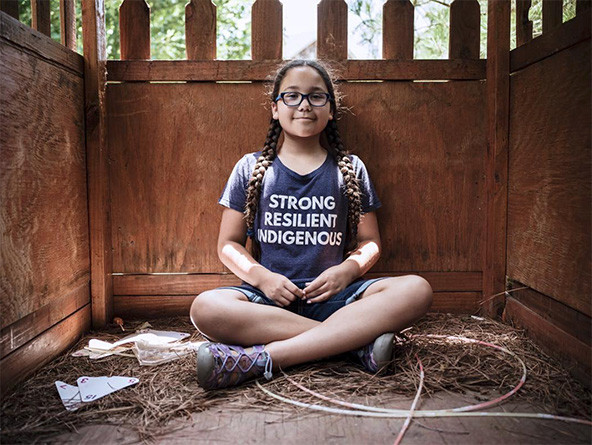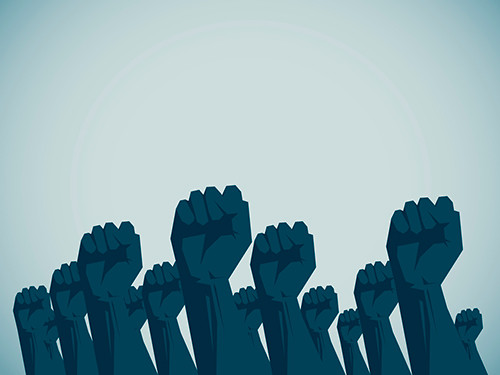 (Photo by Ryan Red Corn)
(Photo by Ryan Red Corn)
We are in a moment of awakening. As a nation, we are beginning to recognize the institutionalized bias and racism that impacts the lives of Black, Native American, and other people of color, starting conversations everywhere from living rooms to boardrooms and moving to the millions of protestors in the streets and the toppling of monuments and symbols of racism. These seismic shifts in culture and society have the potential to catalyze the long overdue end of systemic racism.
It is in this moment that we begin to understand the potential of narrative to shift culture, policies, institutions, and power in transformational ways. Narratives are cultural ideas or stories that dominate and affect how we view or understand the world, created by systems and institutions like the government, media, education, and entertainment, as well as by myths, stereotypes, and personal experiences.

How and where power is held and exercised is embedded in and supported by a society’s dominant narratives. The United States is built on a series of master narratives that are pervasive across all aspects of our society, from the “discovery” of America through manifest destiny to ideas about American exceptionalism and the primacy of “market freedom” at almost any cost. But this country is just as much constructed out of the narratives that aren’t told, stories about stolen Native American lands and stolen Black bodies and labor that get swept under the rug or dismissed. For more than 500 years, this worldview has portrayed Native peoples and Black peoples as less than human and has justified their genocide, forced removal, enslavement, and criminalization for the higher good, “safety,” and progress of this country.
This master narrative is alive and well, with real and deadly implications for Native, Black, and Brown communities.
Master Narratives, Invisibility, and Stereotypes
In 2016, I and a group of Native colleagues led the Reclaiming Native Truth project, a $3.3 million initiative that was the largest public opinion research project ever conducted about Native Americans. Our goal was to examine the dominant narratives in American society about Native peoples, asking where they originate and how they impact public perceptions, opinions, attitudes, and behaviors of non-Native individuals and institutions towards Native Americans.
We found that the largest narrative barrier facing Native peoples is invisibility in the minds of the public, the media, the education system, and popular culture:
- 78 percent of Americans said they know little to nothing about Native Americans.
- 87 percent of schools don’t teach about Native peoples past 1900.
- 95 percent of images that appear in internet searches of “Native Americans” are antiquated, pre-1900 portrayals of Native peoples
- Representation of Native peoples in TV and film is less than 0.4 percent.
- A significant percentage of Americans weren’t even sure that Native Americans still existed (and believed that, if we did exist, we must be a dwindling population).
This invisibility impacts Native peoples, communities, and tribal nations. But our two-year research journey explored how this pernicious invisibility creates space that is filled by misinformation, stereotypes, and false narratives. These toxic narratives fall into several buckets:
- The belief that Native peoples are a “vanishing race,” reducing the exploitation, genocide, forced removal, and assimilation experienced by Native communities to romantic stereotypes from idealized and false myths about Columbus, Pocahontas, and Thanksgiving.
- The belief that Native Americans are conquered and broken peoples, alcoholics and addicts drowning in poverty while living off government benefits.
- The belief that Native Americans are getting rich off corrupt tribal casinos, which are seen as plagued by criminal activity.
- The caricatures of racist sports team names, mascots, and fan behavior.
Because of the invisibility of real Native people, these false narratives and toxic stereotypes are the average American’s only exposure to Native people. Take the racial slur that named the Washington football team or the cartoonish and racist tomahawk and “Native American chants” at the 2020 Super Bowl: despite scientific evidence on the psychological harm it causes to Native youth—and data showing that the majority of Native peoples in this country are offended by these racist team names, mascots, and fan behavior—it is far more common to see racist depictions of Native people in the media than to see real Native people.
This toxic combination of invisibility and racism fuels discrimination against Native Americans and helps to prevent Native peoples from having a seat at decision-making tables, with consequences for Native peoples in government, courts, philanthropy, education, and other influential sectors. The members of Congress we interviewed stated that the invisibility of contemporary Native peoples affects policy, and the majority of federal judges and law clerks interviewed had not taken a federal Indian law course. A number of them made outright derogatory and negative statements about federal Indian law and tribes. Leaders in philanthropy interviewed also echoed how invisibility and stereotypes about Native communities contribute to the lack of foundation giving to Native nonprofits and tribes.
Native invisibility also impacts how Americans think about social justice and discrimination in this country, since nearly two-thirds of Americans do not believe Native Americans face discrimination. But a lack of knowledge about Native peoples predicts less support among non-Native Americans for legislation and policy that advances and protects the rights of Native peoples.
None of this is surprising: people do not care about people they do not see or understand.
How We Move Forward
While our research showed the scope of the problem, it also showed the path forward to changing the narrative. To build the power for Native peoples, we must increase our visibility, amplify accurate representations, and build our presence in key sectors of society and institutions. But it’s not just Native peoples who support and advocate for this representation. Our research showed that non-Native people want better representation of us as well.
- 78 percent of Americans want to learn more about Native people, our histories, our cultures, and contemporary stories.
- 78 percent of Americans also believe that it’s important to feature more stories about Native peoples in television and movies.
- 72 percent of Americans support changes to K-12 curriculum to include Native peoples.
Building Power Through Visibility
Ensuring and prioritizing representation and storytelling for and by Native peoples and people of color is part of the work we have to do. We need contemporary stories of Native peoples. We have to increase the representation of Native peoples in popular culture, both in front and behind the camera. We have to elect Native representatives to local, state, and federal government so that Native people can be included. Native researchers and Native people must be involved in the collection of data, and government agencies must ensure that Native peoples are included in all data. We need more news organizations to employ Native journalists and editors to ensure accurate, nuanced coverage of Native peoples. We need philanthropy to recruit Native board members and executives and to equitably fund Native-led organizations and solutions. We need K-12 schools to provide quality and culturally competent education that teaches both an accurate history of Native Americans in this country but also educates students about tribal sovereignty, contemporary issues, and the contributions of Native peoples.
But it’s not only about making room for Native people in positions of power. It’s also about actively ending the means by which we are harmed. We have to end the use of Native mascots. We must stop perpetuating false narratives of Native people. We must end the legal loopholes that make it possible for Native women and girls to be murdered and stolen with little attention.
Most importantly, as allies, it’s imperative that you include Native peoples in the important conversations happening on everything from systemic racism and dealing with COVID-19 to looking ahead to the “new normal” and the just and equitable future we must collectively work to build. It’s imperative that we’re leading and participating in the conversations and work to create solutions. All must be an active partner in the continuous and concerted movement to end the systemic racism and erasure experienced by Native peoples.
Truth Is an Opportunity
Most of all, we must tell the truth. We must acknowledge that America was built on stolen land and by stolen bodies. Our opportunity is to speak truth to power and fully acknowledge this story and the pain and devastation that still manifests itself today through systemic racism towards Native, Black, and Brown communities.
We have the opportunity to change the American story going forward, which in turn can and will affect real change. Narrative and culture change in this moment means we need to center and listen to the voices of Native peoples and communities of color. We need to ensure that there are opportunities and platforms to share these American stories of Native, Black, and Brown communities that are reflective of our humanity, diversity, commonalities, beauty, challenges, and contributions we all make to this country. This new inclusive and truthful American story can lead to the transformational change we need.
Support SSIR’s coverage of cross-sector solutions to global challenges.
Help us further the reach of innovative ideas. Donate today.
Read more stories by Crystal EchoHawk.

